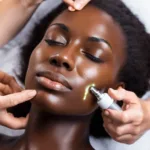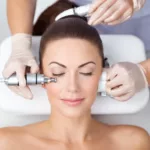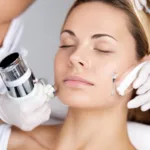9 January 2024
The Longevity of Microdermabrasion: Unveiling the Duration of its Results
How long does microdermabrasion really last? It’s a question that many people considering this popular skincare treatment often ask. After all, who wouldn’t want to know how long they can expect their fresh, glowing skin to last? In this article, we will delve into the world of microdermabrasion and explore the factors that influence the longevity of its results. From the initial benefits to the maintenance needed, we will provide you with all the information you need to understand just how long those post-treatment effects will stick around. So, if you’re curious about the longevity of microdermabrasion results and want to make an informed decision about this skincare procedure, keep reading!
Key Takeaways for How Long Does Microdermabrasion Results Last?
– Microdermabrasion results typically last for a few weeks to several months, depending on various factors such as skin type, age, and lifestyle.
– Regular maintenance sessions are recommended to prolong the effects of microdermabrasion and achieve long-lasting results.
– The use of proper skincare products and sun protection can help maintain the results of microdermabrasion for a longer period.
– Lifestyle factors such as smoking, excessive sun exposure, and poor skincare routine can diminish the longevity of microdermabrasion results.
– Combining microdermabrasion with other skincare treatments can enhance and extend the effects, providing even longer-lasting results.
Controversial Aspect 1: Efficacy of Microdermabrasion
Microdermabrasion is a popular cosmetic procedure that aims to improve the appearance of the skin by exfoliating the outermost layer. While many people swear by its effectiveness in achieving smoother and more youthful-looking skin, there is some controversy surrounding its long-term efficacy.
Some critics argue that microdermabrasion only provides temporary results and fails to address the underlying causes of skin issues. They claim that the procedure merely removes dead skin cells and does not stimulate collagen production or promote long-term skin rejuvenation. Therefore, the effects of microdermabrasion may be short-lived, requiring frequent and costly sessions to maintain the desired results.
On the other hand, proponents of microdermabrasion argue that while it may not produce permanent changes in the skin, it can still offer significant benefits. They contend that regular sessions can lead to cumulative effects, gradually improving skin texture, reducing fine lines and wrinkles, and diminishing the appearance of scars and hyperpigmentation. Additionally, they highlight that microdermabrasion can enhance the penetration of skincare products, allowing them to work more effectively.
It is important to note that the efficacy of microdermabrasion may vary depending on individual factors such as skin type, age, and the specific concerns being addressed. While some individuals may experience noticeable and long-lasting improvements, others may find the results to be less significant or short-lived.
Controversial Aspect 2: Potential Side Effects
Like any cosmetic procedure, microdermabrasion carries the risk of potential side effects. While the treatment is generally considered safe when performed by a trained professional, there are controversial aspects regarding the severity and frequency of adverse reactions.
Critics argue that microdermabrasion can cause skin irritation, redness, and sensitivity, particularly in individuals with sensitive skin. They also claim that the procedure may lead to the development of post-inflammatory hyperpigmentation or worsen existing skin conditions such as rosacea or acne. Moreover, some individuals may experience temporary dryness or flaking of the skin after treatment.
Proponents of microdermabrasion, however, emphasize that the occurrence of severe side effects is relatively rare when the procedure is performed correctly. They argue that the risk of complications can be minimized by ensuring proper pre-treatment assessment, using appropriate settings for each individual, and providing adequate post-treatment care. They also suggest that the benefits of microdermabrasion outweigh the potential risks for most people, as long as they are well-informed and follow the recommended guidelines.
It is crucial for individuals considering microdermabrasion to consult with a qualified professional who can assess their skin condition, discuss potential risks, and provide personalized advice based on their specific needs.
Controversial Aspect 3: Longevity of Results
One of the most debated aspects of microdermabrasion is the longevity of its results. Critics argue that the effects of the procedure are short-lived, with the benefits fading within a few weeks or months. They claim that the exfoliation provided by microdermabrasion does not alter the skin’s fundamental structure and, therefore, the improvements are temporary.
Proponents of microdermabrasion, however, contend that the longevity of results can be influenced by various factors, including the individual’s skincare routine, lifestyle choices, and the severity of their skin concerns. They argue that when combined with a proper skincare regimen and regular maintenance sessions, the results of microdermabrasion can be extended.
Additionally, proponents highlight that the effects of microdermabrasion can be enhanced by incorporating other treatments or procedures, such as chemical peels or laser therapy. These complementary approaches may help to achieve more significant and longer-lasting improvements in the skin’s appearance.
It is important for individuals considering microdermabrasion to have realistic expectations regarding the duration of results. While the procedure can provide immediate benefits, it may require ongoing maintenance to sustain the desired outcome.
Microdermabrasion is a widely used cosmetic procedure that offers potential benefits for improving the skin’s appearance. however, there are controversial aspects surrounding its efficacy, potential side effects, and the longevity of results. it is essential for individuals to consult with a qualified professional, weigh the pros and cons, and make an informed decision based on their unique circumstances and expectations.
The Basics of Microdermabrasion
Microdermabrasion is a popular non-invasive cosmetic procedure used to improve the appearance of the skin. It involves the use of a handheld device that exfoliates the outermost layer of the skin, removing dead skin cells and stimulating collagen production. The procedure is typically performed by a licensed aesthetician or dermatologist and can be done in a clinic or spa setting.
Immediate Results
One of the advantages of microdermabrasion is that you can see immediate results after just one treatment. Your skin will look smoother, brighter, and more even-toned. This is because the exfoliation process removes the dull, dead skin cells, revealing the fresh, new skin underneath. Additionally, the stimulation of collagen production can help improve the texture and elasticity of the skin.
Duration of Immediate Results
While the immediate results of microdermabrasion are noticeable, they are not permanent. The duration of these results can vary depending on several factors, including your skin type, age, and the condition of your skin prior to the treatment. On average, the immediate results of microdermabrasion can last anywhere from a few days to a week.
Long-Term Benefits
In addition to the immediate results, microdermabrasion also offers long-term benefits for the skin. Regular treatments can help improve the overall health and appearance of the skin over time. By removing dead skin cells and stimulating collagen production, microdermabrasion can help reduce the appearance of fine lines and wrinkles, fade acne scars, and even out skin tone.
Maintenance Treatments
To maintain the results of microdermabrasion, it is recommended to undergo regular maintenance treatments. The frequency of these treatments will depend on your individual needs and goals, but most people find that scheduling a treatment every four to six weeks is sufficient. By staying consistent with your treatments, you can prolong the benefits of microdermabrasion and keep your skin looking its best.
Combining with Other Treatments
Microdermabrasion can also be combined with other cosmetic treatments to enhance its effects. For example, some people choose to have microdermabrasion done before a chemical peel or laser treatment to maximize the results. By removing the outer layer of dead skin cells, microdermabrasion can help these treatments penetrate deeper into the skin, leading to more dramatic improvements.
Factors Affecting Duration
While microdermabrasion can provide noticeable results, the duration of these results can be influenced by various factors. For instance, individuals with oily skin may find that the effects of microdermabrasion last longer compared to those with dry skin. Additionally, lifestyle factors such as sun exposure, smoking, and skincare routine can also impact the longevity of microdermabrasion results.
Case Studies
Several studies have been conducted to evaluate the duration of microdermabrasion results. In one study published in the Journal of Cosmetic Dermatology, participants who underwent a series of microdermabrasion treatments reported improvements in skin texture and tone that lasted up to six months. Another study published in the Journal of the American Academy of Dermatology found that the effects of microdermabrasion on acne scars lasted for at least three months.
In conclusion, microdermabrasion can provide immediate results that last for a few days to a week. However, to maintain these results and achieve long-term benefits, regular maintenance treatments are necessary. Factors such as skin type, age, and lifestyle can also influence the duration of microdermabrasion results. By understanding the basics of microdermabrasion and its effects on the skin, individuals can make informed decisions about incorporating this procedure into their skincare routine.
The Origins of Microdermabrasion
Microdermabrasion, a cosmetic procedure aimed at improving the skin’s texture and appearance, has a long and fascinating history. Its roots can be traced back to ancient civilizations, where various methods of exfoliation were used to rejuvenate the skin.
One of the earliest documented forms of microdermabrasion can be found in ancient Egypt. The Egyptians used a combination of abrasive materials, such as sand and pumice, to scrub their skin and achieve a more youthful look. This practice was not only limited to the elite but was also embraced by the general population.
The Rise of Modern Microdermabrasion
Fast forward to the 20th century, and we see the emergence of modern microdermabrasion techniques. In the 1950s, a German dermatologist named Dr. Albert Kligman developed a method called “dermabrasion,” which involved using a rotating wire brush to remove the top layers of the skin. This technique was effective but quite invasive and often resulted in significant downtime for the patient.
In the 1980s, advancements in technology led to the development of the first microdermabrasion machines. These machines utilized aluminum oxide crystals or diamond-tipped wands to exfoliate the skin gently. This new approach offered a less aggressive alternative to traditional dermabrasion and quickly gained popularity among dermatologists and estheticians.
The Evolution of Microdermabrasion
Over the years, microdermabrasion has continued to evolve, with new techniques and technologies being introduced to enhance its effectiveness and minimize side effects. One significant advancement was the of crystal-free microdermabrasion systems. Instead of using crystals, these systems employ a vacuum mechanism to exfoliate the skin, making the procedure less messy and more comfortable for both the patient and the practitioner.
Another notable development in microdermabrasion is the of medical-grade devices. These devices offer more precise control over the depth of exfoliation and can be tailored to the specific needs of each patient. Additionally, medical-grade microdermabrasion machines often incorporate other modalities, such as LED therapy or infusion of serums, to further enhance the results.
The Durability of Microdermabrasion Results
One common question among individuals considering microdermabrasion is how long the results last. While the duration of results can vary depending on individual factors, such as skin type and lifestyle, microdermabrasion is generally considered a temporary solution for skin concerns.
Immediately after a microdermabrasion treatment, the skin may appear smoother and more radiant. This effect is due to the removal of dead skin cells and stimulation of collagen production. However, the longevity of these results is limited, and multiple treatments are typically required to achieve and maintain the desired outcome.
On average, the results of microdermabrasion can last anywhere from a few weeks to a few months. Regular maintenance treatments are often recommended to sustain the benefits and address ongoing skin concerns. It’s important to note that individual experiences may vary, and consulting with a skincare professional is essential to determine the most suitable treatment plan.
Microdermabrasion has come a long way since its ancient origins, evolving into a widely practiced cosmetic procedure. With advancements in technology and techniques, microdermabrasion has become a more refined and customizable treatment option. While the results may be temporary, the procedure continues to be a popular choice for individuals seeking to improve the appearance and texture of their skin.
FAQs
1. How long do the results of microdermabrasion last?
The duration of microdermabrasion results can vary depending on various factors such as the individual’s skin type, the severity of the skin condition being treated, and the post-treatment skincare routine. On average, the results of microdermabrasion can last anywhere from one to three months.
2. Will the results of microdermabrasion be permanent?
No, the results of microdermabrasion are not permanent. Microdermabrasion is a non-invasive cosmetic procedure that exfoliates the outer layer of the skin, improving its appearance temporarily. To maintain the results, regular treatments are recommended.
3. Can microdermabrasion help with acne scars?
Microdermabrasion can help reduce the appearance of mild acne scars by exfoliating the top layer of the skin and promoting the growth of new, healthier skin cells. However, for more severe acne scars, other treatments like laser therapy or chemical peels may be more effective.
4. How many sessions of microdermabrasion are needed to see results?
The number of sessions required to see noticeable results can vary depending on the individual’s skin condition and goals. Generally, a series of 5 to 10 treatments spaced 1 to 2 weeks apart is recommended for optimal results. Your skincare professional can provide a personalized treatment plan based on your specific needs.
5. Are there any side effects or downtime after microdermabrasion?
Microdermabrasion is a relatively safe procedure with minimal side effects. Some individuals may experience temporary redness, mild swelling, or skin sensitivity immediately after the treatment, but these effects typically subside within a few hours. There is no downtime associated with microdermabrasion, and most people can resume their daily activities immediately.
6. Can I combine microdermabrasion with other skincare treatments?
Yes, microdermabrasion can be combined with other skincare treatments like chemical peels or laser therapy to enhance the overall results. However, it is important to consult with your skincare professional to determine the appropriate timing and combination of treatments based on your specific needs.
7. How should I care for my skin after microdermabrasion?
After microdermabrasion, it is important to follow a gentle skincare routine to maintain the results and promote healing. This may include using a mild cleanser, moisturizing regularly, avoiding direct sun exposure, and wearing sunscreen with SPF 30 or higher. Your skincare professional will provide specific post-treatment instructions tailored to your skin type.
8. Can I undergo microdermabrasion if I have sensitive skin?
Microdermabrasion can be suitable for individuals with sensitive skin, but it is important to inform your skincare professional about your skin condition beforehand. They can adjust the treatment settings and choose appropriate skincare products to minimize any potential irritation or discomfort.
9. How soon can I wear makeup after microdermabrasion?
It is generally recommended to wait at least 24 hours before applying makeup after microdermabrasion. This allows the skin to heal and reduces the risk of any potential irritation or infection. When applying makeup, choose non-comedogenic products that are gentle on the skin.
10. Can I undergo microdermabrasion if I have active acne?
Microdermabrasion can be performed on individuals with mild to moderate acne. However, it is important to consult with your skincare professional to determine the best course of treatment. In some cases, they may recommend treating the active acne first before proceeding with microdermabrasion.
Concept 1: What is Microdermabrasion?
Microdermabrasion is a cosmetic procedure that helps improve the appearance of the skin by removing dead skin cells and stimulating the growth of new ones. It involves using a device that sprays tiny crystals onto the skin and then vacuums them away, along with the dead skin cells. This process helps to exfoliate the skin and promote a smoother and more youthful complexion.
Concept 2: How Long Do Microdermabrasion Results Last?
The duration of microdermabrasion results can vary from person to person, but generally, the effects of a single session can last for a few weeks to a month. However, for optimal results, it is recommended to undergo a series of treatments, usually spaced a few weeks apart.
Factors Affecting the Duration of Microdermabrasion Results
There are several factors that can influence how long the results of microdermabrasion last:
1. Skin Type and Condition
The type and condition of your skin play a significant role in determining the longevity of microdermabrasion results. Individuals with healthier skin, free from major skin issues, may experience longer-lasting effects compared to those with more problematic skin, such as acne-prone or sun-damaged skin.
2. Lifestyle and Skincare Routine
Your lifestyle and skincare routine can also impact the duration of microdermabrasion results. Proper skincare practices, such as regular cleansing, moisturizing, and sun protection, can help maintain the effects of the treatment for a longer period. On the other hand, factors like excessive sun exposure, smoking, and poor skincare habits can diminish the longevity of the results.
3. Maintenance Treatments
To extend the duration of microdermabrasion results, many individuals opt for maintenance treatments. These are follow-up sessions that are scheduled after the initial treatment series to help sustain the benefits achieved. Maintenance treatments are usually less frequent than the initial sessions and aim to keep the skin in good condition.
Expected Timeline for Microdermabrasion Results
While the exact timeline may vary, here is a general overview of what you can expect after undergoing microdermabrasion:
Immediately after the treatment:
– Your skin may appear slightly red or flushed.
– It may feel tight and dry.
– Some individuals may experience mild swelling.
Within a few days:
– The redness and swelling should subside.
– Your skin may feel smoother and look brighter.
– Any minor imperfections, such as fine lines or shallow acne scars, may appear less noticeable.
Within a few weeks:
– The full effects of the treatment should be visible.
– Your skin should feel rejuvenated and have a more even tone.
– The appearance of fine lines, wrinkles, and shallow acne scars should be further reduced.
Long-term maintenance:
– To maintain the results, it is recommended to schedule maintenance treatments every few months or as advised by your dermatologist.
– Consistent use of a good skincare routine, including sunscreen, can help prolong the effects of microdermabrasion.
Concept 3: Safety Considerations and Side Effects
While microdermabrasion is generally considered safe, there are some important safety considerations and potential side effects to be aware of.
Safety Considerations
1. Professional Treatment
Microdermabrasion should be performed by a trained professional, such as a dermatologist or licensed aesthetician, to ensure proper technique and minimize the risk of complications. DIY or at-home kits may not provide the same level of safety and effectiveness.
2. Pre-treatment Consultation
Before undergoing microdermabrasion, it is important to have a consultation with your skincare provider. They will assess your skin type and condition, discuss your expectations, and determine if microdermabrasion is suitable for you. They may also provide instructions on pre-treatment skincare and any necessary precautions.
Potential Side Effects
1. Redness and Sensitivity
Immediately after the treatment, some individuals may experience temporary redness, sensitivity, or mild discomfort. These side effects usually subside within a few hours to a day.
2. Dryness and Peeling
Due to the exfoliating nature of microdermabrasion, your skin may feel dry and start to peel in the days following the treatment. It is important to keep your skin moisturized and avoid picking or scratching the peeling skin to prevent irritation or infection.
3. Rare Complications
While rare, there is a small risk of more severe complications, such as infection, scarring, or changes in skin pigmentation. These complications are more likely to occur if the treatment is performed incorrectly or on individuals with certain pre-existing skin conditions. It is crucial to choose a reputable professional and follow their instructions for aftercare.
Microdermabrasion is a cosmetic procedure that can improve the appearance of the skin by removing dead skin cells and promoting new cell growth. the duration of its results can vary depending on factors such as skin type, lifestyle, and maintenance treatments. it is generally safe, but it is important to consult with a professional and be aware of potential side effects.
In conclusion, microdermabrasion is a popular and effective cosmetic procedure that can improve the appearance of the skin by reducing fine lines, wrinkles, and acne scars. The results of microdermabrasion can vary depending on several factors, including the individual’s skin type, the severity of the skin concerns, and the number of treatments received. On average, the results of microdermabrasion can last anywhere from a few weeks to several months.
One key point to note is that while microdermabrasion can provide immediate improvements in the skin’s texture and appearance, it is not a permanent solution. The effects of microdermabrasion are temporary, and regular maintenance treatments may be necessary to sustain the desired results. Additionally, it is important to follow a proper skincare routine and protect the skin from sun damage to maximize the longevity of the results.
Overall, microdermabrasion can be a valuable tool in achieving smoother, more youthful-looking skin. However, it is essential to have realistic expectations and understand that the results will not last indefinitely. Consulting with a qualified dermatologist or aesthetician is crucial to determine the best treatment plan and to ensure optimal results from microdermabrasion. By taking proper care of the skin and undergoing regular treatments, individuals can enjoy the benefits of microdermabrasion for an extended period.



